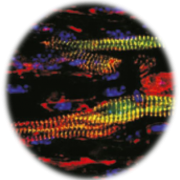Scientific Profile
Therap eutic options for patients suffering from heart failure are poor. It is the goal of the CRC 1002 to identify new specific treatment targets and develop new therapeutic strategies to treat heart failure. Identification of therapy targets is pursued by evaluation of the spatial organization of signal transduction in nano- and micro-domains. Our strategy is based on the assumption that key regulatory processes are compartmentalized. The specific localized therapy targets are defined as "modulatory units". During the first funding period we focus on target identification, but in subsequent funding periods, development of therapeutic strategies into clinical phases I and II is foreseen. We define the following project areas:
eutic options for patients suffering from heart failure are poor. It is the goal of the CRC 1002 to identify new specific treatment targets and develop new therapeutic strategies to treat heart failure. Identification of therapy targets is pursued by evaluation of the spatial organization of signal transduction in nano- and micro-domains. Our strategy is based on the assumption that key regulatory processes are compartmentalized. The specific localized therapy targets are defined as "modulatory units". During the first funding period we focus on target identification, but in subsequent funding periods, development of therapeutic strategies into clinical phases I and II is foreseen. We define the following project areas:
- Functional microdomains such as 1) cAMP- and cGMP-microdomains as local intracellular key mechanisms of pathophysiological signal transduction or 2) calcium release units consistent of L-type calcium channels and ryanodin receptors. Project area A investigates localized intracellular processes.
- Sensor complexes such as 1) the titin molecule as a potential sensor of myocyte stretch (preload) and the subsequent transformation of hemodynamic load into cellular signal transduction or 2) the complex consisting of hypoxia inducible factor and prolyl-4-hydroylase(PHD)-domain-enzymes (HIF-1α/PHD) as oxygen and hypoxia sensors. Project area B defines molecular mechanisms as sensing events of the functional status of the myocyte, which will be transferred into cellular processes.
- Cell-cell-interaction via extracellular signaling compartments in the communication between myocytes, endothelial cells, fibroblasts and immune cells. Project area C evaluates poorly understood cross-talk mechanisms of the stromal compartment of the multicellular organ.
Project areas are deeply interconnected.
CRC 1002 PIs agreed on a common data policy which is availabale here.









